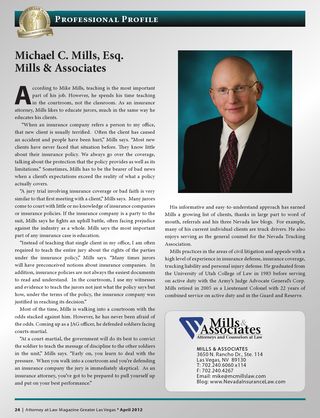A number of states have formally recognized a cause of action for negligent repair of a vehicle. Francher v. Southwest Mo. Truck Ctr., Inc., 618 S.W.2d 271 (Mo. App. 1981). Olchovy v. L.M.V. Leasing, 182 A.D.2d 745, 582 N.Y.S.2d 764 (2d Dep’t 1992). Others allow a cause of action for breach of the implied warranty of repair, meaning that repairs were not done in a workmanlike manner. Hutson v. Cummins Carolinas, Inc., 314 S.E.2d 19 (S.C. App. 1984). Although the Nevada Supreme Court has recognized causes of action for negligence and implied warranties in other contexts, it has never had a case in which it had to decide whether negligent repair or breach of implied warranty of repair are legitimate causes of action under Nevada law.
The case that came closest to answering that question was Stubli v. Big D International Truck, Inc., 107 Nev. 309, 810 P.2d 785 (1991). In that case, Plaintiffs brought suit for negligent repair and products liability against Big D and the trailer’s manufacturer, The Budd Company, respectively. A springhanger on the trailer’s suspension had broken lose and Big D welded it back onto the trailer frame. Later, the tractor-trailer was involved in a single vehicle accident on I-80 in Wyoming. The Owner, Stubli brought suit for the damage to the tractor-trailer.
Stubli’s expert examined the trailer and opined that it was either a manufacturing defect or a repair defect that caused the trailer to fail a second time, resulting in the accident. The Plaintiff saved the failed parts, but did not save the entire trailer. This was his downfall. When the Defendants asked to inspect the vehicle, and only certain parts were available, Defendants filed a Motion to Dismiss as a sanction for spoliation of the evidence. See, e.g., Fire Ins. Exchange v. Zenith Radio Corp., 103 Nev. 648, 649, 747, P.2d 911, 912 (1987). That motion was granted. The Supreme Court upheld the District Court’s dismissal of the action as a sanction for failure to keep the evidence.
Since the Nevada Supreme Court made no comment on the theoretical concept of a cause of action for negligent repair, one can assume that a Plaintiff would face little challenge in bringing such a claim in the future. However, the Plaintiff should maintain the vehicle so that it can be inspected by the opposing party and thereby avoid the same consequences that befell Mr. Stubli.
 Follow
Follow Email
Email


